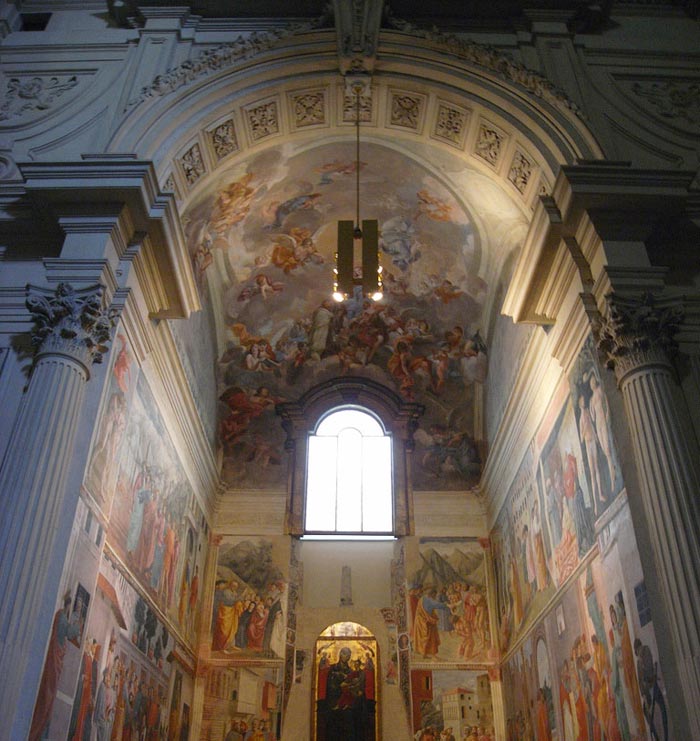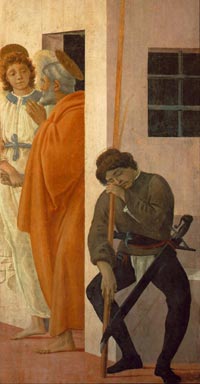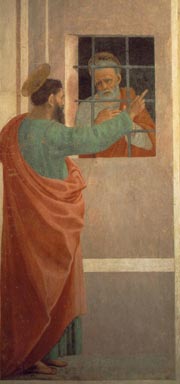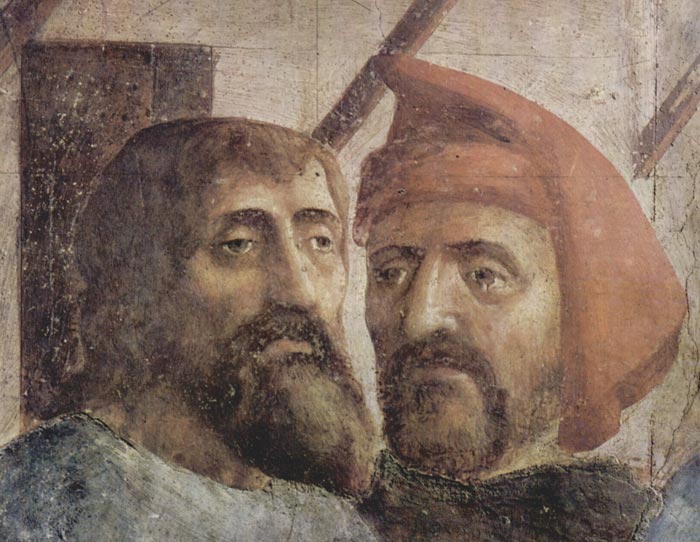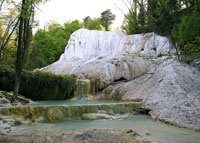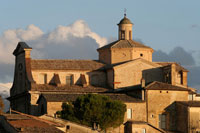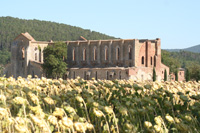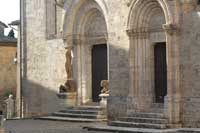| |
|
Filippino Lippi was among the most gifted and accomplished Florentine painters and draftsmen of the second half of the fifteenth century. He was born in 1456/57, the product of a famous and illicit relationship between the painter Fra Filippo Lippi and the young nun Lucrezia Buti.
Art historians classify Filippino Lippi’s early pieces as reflective of Botticelli’s style. After the death of his father, Fra Filippo Lippi, when Filippino was 12, he entered the workshop of Sandro Botticelli and absorbed many aspects of his style.
Filippino's first major project was the completion of the fresco cycle begun by Masaccio and Masolino in the Brancacci Chapel, Santa Maria del Carmine, Florence, which had remained unfinished for more than half a century. Here Filippino adjusted his style to allow his contribution to seamlessly mesh with Masaccio's more monumental manner.
Filippino painted several other frescoes, the most important of which are cycles on the life of St Thomas Aquinas (1488-93) in the Carafa Chapel, Sta Maria sopra Minerva, Rome, and the lives of Sts Philip and John (1495-1502) in the Strozzi Chapel, Sta Maria Novella, Florence. In these he strove for picturesque, dramatic and even bizarre effects that reveal him as one of the most inventive of late Quattrocento painters. His years in Rome gave him the opportunity to study antique remains: ever afterwards he introduced bits and pieces of antiquity into all his pictures, whether suitable or not.
Filippino also painted many altarpieces, the most famous of which is the Vision of St Bernard (Badia, Florence, c. 1480), an exquisitely tender work, full of beautiful detail. There are many panels datable in the 1490s and the last years of his life, but like Botticelli, his style went out of date in his lifetime: it is sometimes called 'Quattrocento Mannerism'.
Although he is now somewhat undershadowed by Botticelli, Filippino enjoyed a great reputation in his lifetime, being described by Lorenzo de' Medici as 'superior to Apelles'.
|
| The Brancacci Chapel or Cappella dei Brancacci is a chapel in the Church of Santa Maria del Carmine in Florence. It is sometimes called the Sistine Chapel of the early Renaissance for its painting cycle, among the most famous and influential of the period. Construction of the chapel was commissioned by Pietro Brancacci and begun in 1386. Little remains of the mediaeval building, not only because of the extensive 16th-century alterations but also because of a disastrous fire which gutted the church in 1771. What we see today is in large part the result of the late-baroque rebuilding carried out after the fire by Giuseppe Ruggieri. The fire did not however affect the old sacristy, which still has its chapel with Scenes from the life of St Cecilia attributed to Lippo d’Andrea (c. 1400), the Brancacci Chapel in the right transept, or the Corsini Chapel in the left.
Public access is currently gained via the neighbouring convent, designed by Brunelleschi. The church and the chapel are treated as separate places to visit and as such have different opening times and it is quite difficult to see the rest of the church from the chapel.
The Brancacci Chapel has one of the supreme masterpieces of renaissance painting: the fresco cycle of Scenes from the life of St Peter, mostly painted in collaboration by Masaccio and Masolino between 1425 and 1427.
The patron of the pictorial decoration was Felice Brancacci, descendant of Pietro, who had served as the Florentine ambassador to Cairo until 1423. Upon his return to Florence, he hired Masolino da Panicale to paint his chapel. Masolino's associate, 21 year old Masaccio, 18 years younger than Masolino, assisted, but during painting Masolino left to Hungary, where he was painter to the king, and the commission was given to Masaccio. By the time Masolino returned he was learning from his talented former student. However, Masaccio was called to Rome before he could finish the chapel, and died in Rome at the age of 27. The chapel’s decoration was completed by Filippino Lippi, who between 1481 and 1485 worked on the lower register of the left wall, finishing the Raising of the son of Theophilus and St Peter enthroned which Masaccio had begun, and painting on his own St Peter in prison visited by St Paul on the adjacent pilaster. On the opposite wall he frescoed the Disputation of St Peter and St Paul with Simon Magus, and the Crucifixion of St Peter, and on the pilaster St Peter visited in prison. Between 1746 and 1748 the chapel was extensively redecorated: Vincenzo Meucci frescoed the ceiling with the Virgin consigning the Scapular to St Simon Stock, thus destroying Masolino’s Evangelists. At the same time the lunettes of the Shipwreck of the Apostles and the Calling of the Apostles were painted over.
[2] Unfortunately during the Baroque period some of the paintings were seen as unfashionable and a tomb was placed in front of them.
|
| |
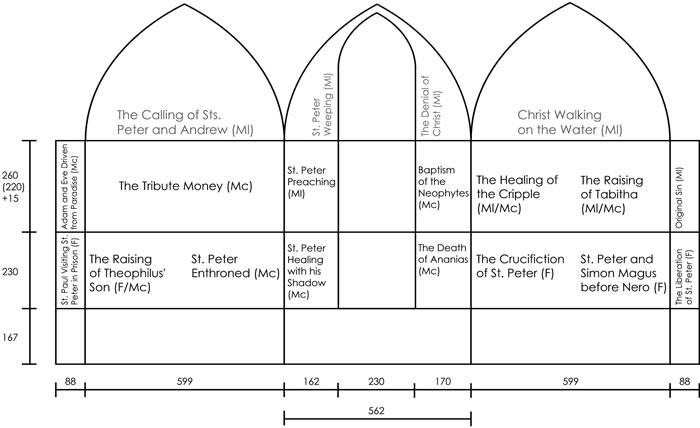 |
| |
| The frescoes in the upper register are: Adam and Eve in the Earthly Paradise, and Original Sin by Masolino, and the Expulsion of Adam and Eve from the Earthly Paradise with the Tribute Money and the Baptism of the neophytes by Masaccio; also by Masolino are the Preaching of St Peter with the Healing of the lame man and the raising of Tabitha. In the lower register, Masaccio painted the two scenes on the end wall, St Peter curing the sick with his shadow and the Distribution of goods, with the death ot Ananias. |
|
|
|
| |
|
|
|
|
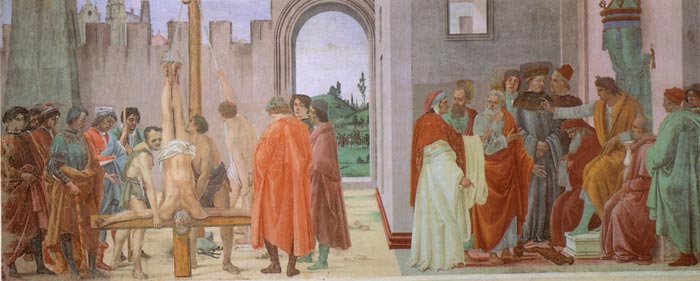 |
|
This fresco depicts the two last episodes from the story of the life of Peter: to the right we see him, with St Paul, in his dispute with Simon Magus in front of the Emperor; to the left, his Crucifixion.
Recently it was suggested that Masaccio had originally painted the last scene of the cycle, the Crucifixion of Peter. But that fresco was then destroyed when the Madonna del Popolo was placed on the altar, so that when Filippino was called in to complete the unfinished cycle and repair the damaged sections, he was also asked to add the scene of the death of Peter on the empty wall space.
|
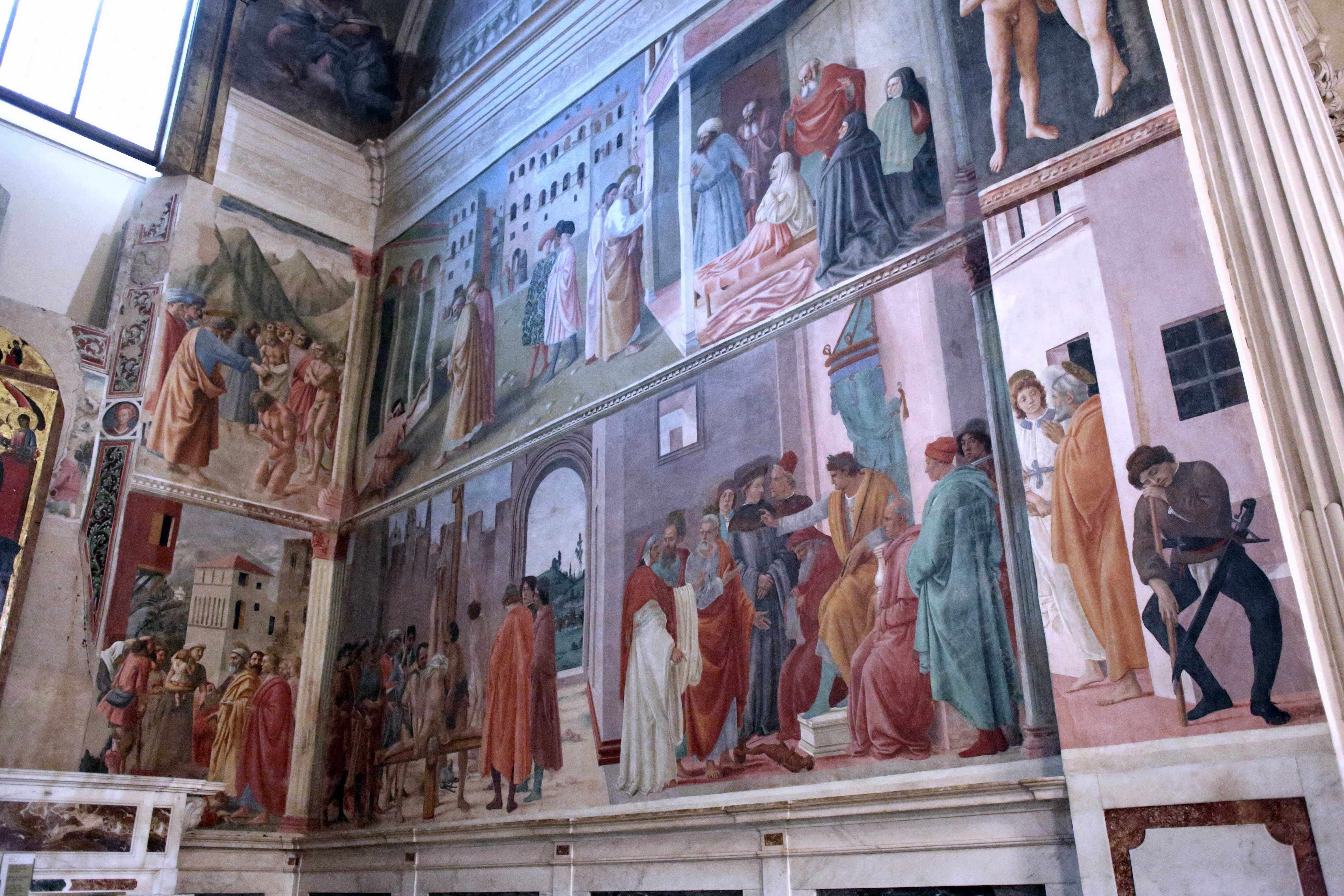 |
Filippino Lippi, Disputation with Simon Magus and Crucifixion of Peter, 1481-82, Brancacci Chapel, Church of Santa Maria del Carmine in Florence [2]
|
Among the portraits Filippino has included in his fresco, the most interesting are the following: a selfportrait (the first figure to the left, looking towards the spectator); the first man to the right of the three men standing between St Peter and Nero is Antonio del Pollaiolo, while the one to the left is probably Raggio, a merchant's broker mentioned by Vasari, and not Botticelli as had been suggested previously; whereas in the group of three to the right in the Crucifixion of Peter, the man looking towards the audience is probably Botticelli.
|
| This is the left side of the fresco showing the crucifixion. |
|
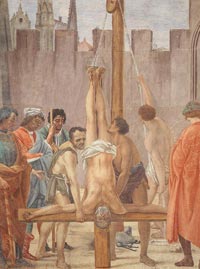
|
| |
|
|
The right side of the fresco is showing the disputation. Among the portraits Filippino has included in his fresco, the most interesting is: a selfportrait (the first figure to the right, looking towards the spectator.
This scenes below arepart of the fresco cycle depicting the story of life of St Peter. On the left, it shows Peter being awoken by the Angel and taken out of his cell, while the guard is sound asleep and notices nothing.On the right, St Paul visits St Peter in Prison.
The fresco was originally attributed to to Masaccio. Since the nineteenth century all critics agree in the attribution to Filippino.
The Golden Legend tells the story of Theophilus, Prefect of Antioch, who put Peter in prison; and there the Apostle would certainly have languished for the rest of his days, had not St Paul, who frequently visited him in his cell, gone to Theophilus and told him that Peter had the power to resurrect the dead. Theophilus was very interested and told Paul that he would have Peter released immediately if he were able to resurrect his son, who had died fourteen years previously.
For a long time the fresco was attributed to Masaccio. Actually, it is the most Masaccesque of Filippino's painting, so much so that it has been suggested that he may have been working from a sinopia prepared by Masaccio.
|
|
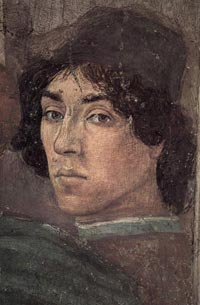
The detail shows the self-portrait of the artist at the extreme right of the scene.
|
|
|
|
|
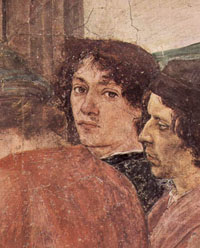
This detail shows the central part of the fresco, a group observing the crucifixion. In this group of three the man looking towards the spectator is probably Sandro Botticelli.
|
St Peter Freed from Prison |
|
St Paul Visits St Peter in Prison |
|
|
|
|
| |
|
|
|
Masaccio | Brancacci Chapel in Santa Maria del Carmine, Florence
|
|
|
St Peter Healing the Sick with his Shadow, (detail) 1426-27, fresco, 230 x 162 cm, Cappella Brancacci, Santa Maria del Carmine, Florence
|
Although only partly by Masaccio, the Brancacci Chapel frescoes stand as Masaccio's most influential work and the one upon which rests his historical position as the first painter of the renaissance. His share in the work was probably done during 1427 and consisted of the Expulsion on the left inner pilaster, the Tribute Money and part of the Raising of the Son of Theophilus and St Peter Enthroned on the left wall. He also painted three scenes dealing with the life of St Peter on the altar wall, the fourth is by Masolino.
|
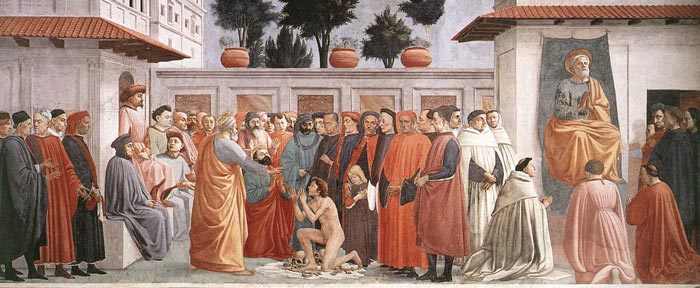 |
|
Masaccio e Filippino Lippi, Resurrezione del figlio di Teofilo e san Pietro in cattedra, 1426-27, affresco, 230 x 598 cm, Cappella Brancacci, Santa Maria del Carmine, Firenze
|
|
|
| |
|

[1] In fifteenth-century Florence, many people believed themselves to be living in a new age. The term "Renaissance," already coined by the sixteenth century, describes the "rebirth" from the dark ages of intellectual decline that followed the brilliance of ancient civilization. In Italy, especially, the Renaissance was spurred by a revival of Greek and Roman learning. Works by classical authors, lost to the West for centuries, were rediscovered, and with them a new, humanistic outlook that placed man and human achievement at the center of all things.
Humanists in Florence styled their city a "new Athens." It was a fiercely mercantile state, struggling to remain independent and committed to republican virtues though controlled in practice by the powerful Medici family. No single factor can explain the unrivaled artistic flowering it experienced in the early 1400s, but the contributions of Brunelleschi in architecture, Donatello in sculpture, and Masaccio in painting changed Western art forever. Brunelleschi measured ancient buildings in Rome to understand the harmony of classical proportions and reintroduced such elements of classical architecture as the columned arcade. He applied engineering genius to design the huge dome for the cathedral of Florence and invented the system of one-point perspective (see below). Donatello, who accompanied Brunelleschi to Rome, carved some of the first large-scale, freestanding statues since antiquity. Like those ancient figures, his were sometimes nude. Masaccio (1401-1427?) was the first great painter of the Italian Renaissance, whose innovations in the use of scientific perspective inaugurated the modern era in painting. In Florence's Brancacci chapel, Masaccio painted a series of innovative frescoes that used light, coming strongly and consistently from a single direction, to model figures with shadow and give them robust three-dimensionality. He put into practice Brunelleschi's theories about how to project depth beyond a flat painted surface, employing the lines of painted architecture to create a convincing illusion of space.
The son of Fra Filippo Lippi, Filippino began his training as a very young boy in his father's workshop. Documents record a partial payment he received in 1469 for the frescoes in the apse of the duomo in Spoleto, whose execution, interrupted by Fra Filippo's death that same year, was completed by the friar's associate Fra Diamante. On his return to Florence, Filippino worked initially with Fra Diamante; according to some scholars, he assisted him in painting the predella panels with stories from the life of Christ now in the Museo Civico in Prato. Soon he moved on, however, to the workshop of Botticelli, where he was active in 1472. During his collaboration with Botticelli, which was probably fairly long, Filippino created a number of panels in which, despite the very strong influence of the master, one readily observes the young Lippi's extraordinary elegance of drawing, subtlety of feeling, and penetrating characterizations. They are so close to Botticelli, however, that Berenson at first considered them the work of a hypothetical "Amico di Sandro," an artist he considered influenced by, but distinct from, both Botticelli and Filippino. These early works include the Tobias and the Three Archangels in the Galleria Sabauda in Turin; five Allegorical Figures in the Galleria Corsini in Florence; stories from the lives of Virginia (Musée du Louvre, Paris), Lucretia (Galleria Palatina, Florence), and Esther (Musée Condé, Chantilly); and others, among them The Coronation of the Virgin in the NGA.
In the 1480s Filippino, by this point an established painter, received numerous commissions for works on a monumental scale, including frescoes, probably never actually painted, for the Sala dell'Udienza in Palazzo Vecchio in Florence. To these years are to be dated two altarpieces for churches in Lucca (four saints for the church of San Michele; side panels each representing two saints for the church of San Ponziano, now in the Norton Simon Museum in Pasadena, California); the Annunciation (1483-1484) for the Palazzo Pubblico of San Gimignano (now in its Museo Civico); the altarpiece of the Otto di Pratica in Palazzo Vecchio (now in the Uffizi, completed February 1486); the Vision of Saint Bernard in the Badia Fiorentina; and the Madonna and Child with Saints painted for the Rucellai chapel in San Pancrazio (now in the National Gallery, London). A sense of the monumental, an acute attention to naturalistic detail, increasingly complex compositional schemes, and an autumnal palette also characterize the Stories from the Life of Saint Peter entrusted to Filippino toward 1483-1484 to complete the decoration of the Brancacci chapel in the church of Santa Maria del Carmine. His highly original artistic language, in which an interest in unusual or bizarre details described with an almost Flemish illusionism coexists evocatively with motifs taken from classical antiquity, is fully expressed in the years around 1490. The principal works of that period are the frescoes in the Carafa chapel in Santa Maria sopra Minerva in Rome (completed in 1493) and some large Florentine altarpieces (the Virgin and Child with Saints and Donors in Santo Spirito and the Adoration of the Magi of 1496, formerly in San Donato agli Scopeti and now in the Uffizi). A particularly imaginative and demanding undertaking was the mural decoration of the Strozzi chapel in Santa Maria Novella in Florence with stories from the lives of Saints Philip and John, begun in 1489 but not completed until 1502, after a long interruption. By this time Filippino's work was in demand in the great art centers all over Italy: he designed an altarpiece of the Pietà for the Certosa near Pavia (of which only the preliminary drawings remain), painted the Mystical Marriage of Saint Catherine in 1501 for San Domenico in Bologna, and two years later executed the Virgin and Child with Saint Sebastian and Other Saints for the church of San Teodoro in Genoa (now Palazzo Bianco). He died in Florence in 1504, leaving numerous works unfinished. The importance of his contribution to the birth and development of Florentine Mannerism was recognized and appreciated by Vasari, who celebrated his "ingegno... tanto bizzarro e nuovo" ("imagination... so curious and original"), observing that Filippino "fu il primo il quale ai moderni mostrasse il nuovo modo di variare gli abiti, e che abbellisse ornatamente con veste antiche succinte le sue figure" ("was the first among the moderns to employ the new method of varying the costumes, and... to embellish his figures with ancient dress").[°] [Filippino Lippi - Biography | National Gallery of Art, Washington, DC]
[°] Giorgio Vasari, Lives of the Painters, Sculptors and Architects, translated by A.B. Hinds, New York, 1968: 199.
[2] Photo by jean louis mazieres, published under a Attribution-NonCommercial-ShareAlike 2.0 Generic (CC BY-NC-SA 2.0) license.
|

Giorgio Vasari | Lives of the Most Eminent Painters Sculptors and Architects
Art in Tuscany | Masaccio | Brancacci Chapel in Santa Maria del Carmine, Florence
Art in Tuscany | Art in Tuscany | Giorgio Vasari | Lives of the Most Excellent Painters, Sculptors, and Architects
Giorgio Vasari | Le vite de' più eccellenti architetti, pittori, et scultori italiani, da Cimabue insino a' tempi nostri | Filippino Lippi
The Metropolitan Museum of Art | From Filippo Lippi to Piero della Francesca: Fra Carnevale and the Making of a Renaissance Master
www.museumsinflorence.com | Brancacci_chapel
|
|
This page uses material from the Wikipedia articles Masaccio and Brancacci Chapel, published under the GNU Free Documentation License.
Wikimedia Commons has media related to: Brancacci Chapel
|

Holiday accomodation in Tuscany | Podere Santa Pia | Artist and writer's residency
|
| |
|
|
|
|

. |
|
|
Podere Santa Pia |
|
Podere Santa Pia, garden view, December |
|
Bagni San Filippo |
| |
|
|
|
|
|
|
|
|
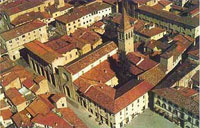
|
Montefalco |
|
The abbey of San Galgano |
|
Sansepolcro |
| |
|
|
|
|
|
|
 |
|
|
Siena, Duomo |
|
San Gimignano |
|
San Qurico d'Orcia
|
| |
|
|
|
|
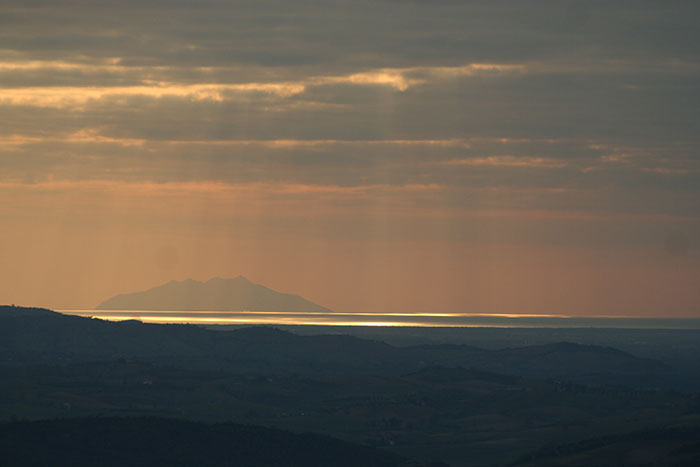 |
Podere Santa Pia, Evening view over the Maremma hills and Monte Christo |
| |
Santa Maria del Carmine, Florence
|
|
|
Santa Maria del Carmine is a church of the Carmelite Order, in the Oltrarno district of Florence, in Tuscany, Italy. It is famous as the location of the Brancacci Chapel housing outstanding Renaissance frescoes by Masaccio and Masolino da Panicale, later finished by Filippino Lippi.
The church, dedicated to the Beatæ Virginis Mariæ de monte Carmelo, was built from 1268 as part of Carmelite convent, which is still existing today. Of the original edifice only some Romanesque-Gothic remains can be seen on the sides. The complex was enlarged a first time in 1328 and again in 1464, when the capitular hall and the refectory added, though the church maintained the Latin Cross, one nave pan.
Renovated in the Baroque style in the 16th-17th centuries, it was damaged by a fire in 1771 and rebuilt internally in the Rococo style in 1782. The façade, like in many Florentine churches, remained unfinished. The fire did not touch the sacristy: therefore have survived the Stories of St. Cecilia attributed to Lippo d'Andrea (c. 1400) and the marble monument of Pier Soderini by Benedetto da Rovezzano (1511-1513). The vault of the nave has a trompe-l'oeil fresco by Domenico Stagi.
Brancacci Chapel
Also the Brancacci Chapel survived the fire, and was also saved by the subsequent restoration by the intervention of a Florentine noblewoman who firmly opposed to the covering of the frescoes. The Chapel is home to the famous frescoes by Masaccio and Masolino, considered the first masterwork of the Italian Renaissance. Masaccio's master, Masolino commissioned by a wealthy merchant, Felice Brancacci, began work on the chapel in 1425 but the project was soon taken over by his pupil whose treatment of figures in believable space made the frescoes among the most important to have come out of the Early Renaissance. The scenes by Masaccio are the Expulsion from Paradise, The Tribute Money St Peter Healing a Lame-Man , and St Peter Raising Tabitha from the dead. The cycle was finished by Filippino Lippi
Corsini Chapel
The Corsini, probably the richest family in Florence during the 17th-18th centuries, had this chapel built in 1675, entitled to St. Andrew Corsini (1301-1374), Carmelite bishop of Fiesole, who had been canonized in 1629. The architect Pier Francesco Silvani choose for it the Baroque style then popular in Rome. The small dome was frescoed by Luca Giordano in 1682. The elaborated Italian Rococo ceiling is from one of the most important 18th century artists in the city, Giovanni Domenico Ferretti.
The convent
The convent suffered in its history from numerous disasters, from the 1771 fire to the 1966 River Arno flood. Most of the artworks are therefore fragmentary: these include the Bestowal of the Carmelite Rule by Filippo Lippi and the Last Supper by Alessandro Allori, and remains of works from other chapels by Pietro Nelli and Gherardo Starnina.
The second refectory is decorated with the Supper in Simon the Pharisee's house by Giovanni Battista Vanni (c. 1645); it also houses fragments of frescoes by Lippo d'Andrea.
|
|
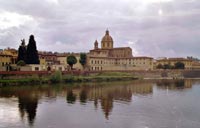
 On November 4, 1966 the Arno river flooded most of the city center damaging millions of art treasures and books. The flood left many marks on the city and its artistic patrimony, many pieces of artwork are still under restoration over 40 years later. On November 4, 1966 the Arno river flooded most of the city center damaging millions of art treasures and books. The flood left many marks on the city and its artistic patrimony, many pieces of artwork are still under restoration over 40 years later.
After the 1966 flood, the restored Ponte Vecchio was closed to vehicular traffic.
|
| |
|
|
|
|
